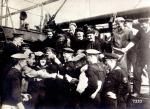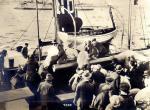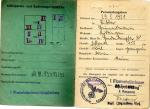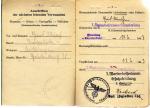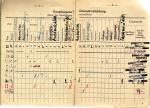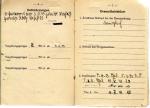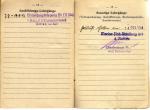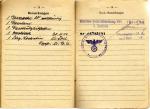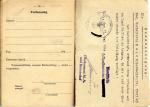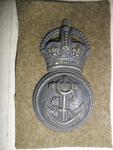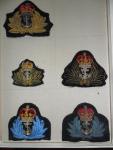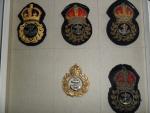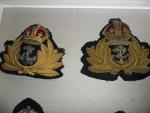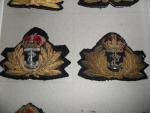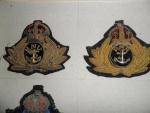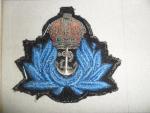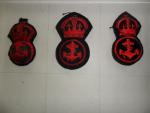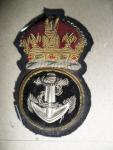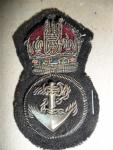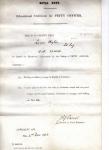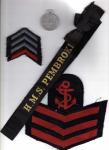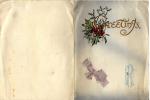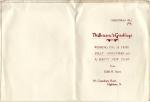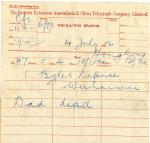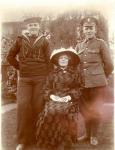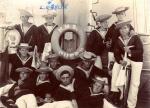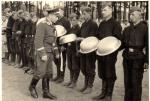-
Posts
2,143 -
Joined
-
Last visited
-
Days Won
10
Content Type
Profiles
Forums
Blogs
Gallery
Events
Store
Everything posted by Odulf
-
"Erinnerung an die 14 täg. Jäger Uebung - Colmar i/E den 22./6./13 - Rheinländer" (Commemoration of the 14 days Rifles Training in Colmar, 22 June 1913) The Jäger with the shako, in the centre, wears the rare Kaiser/Königsabzeichen for Jäger on his right upper sleeve (there were only 19 Jäger and Schützen battalions in the Imperial Army. All men belong to the Grossherzogl. Mecklenburger Jäger-Bataillon Nr.14
-

Uncategorised Iron Cross in Civilian Clothes
Odulf replied to Chris Boonzaier's topic in Germany: All Eras: The Iron Cross
I share the opinion of Bernhard. -
For year on end I have been interested in Naval ships disguished as merchant vessels on their solitary missions, during the 1st and 2nd World Wars. The British had their Armed Merchant Cruisers (AMCs), and the Germans had their Hilfskreuzer (HK). Many men who served in these ships received bravery awards, and a study of the ship's histories never is a dull reading. Thus, I collected some press photos of the German Auxiliary Cruiser SMS Wolf, the converted Hansa-Line freighter "Wachtfels" (all their ships were named "...fels"). This was the most successful German commerce raider, commanded by Fregattenkapitäin Karl August Nerger. Between 1 December 1916 and 26 February 1918 she was on a mission which brought her and her crew great fame, and the cap tally S.M.S. WOLF was much respected [and collectable]. For more information: http://en.wikipedia.org/wiki/SMS_Wolf_(1913) Enclosed some press photos, and some other photographic material. It is interesting, that the day of return, of SMS WOLF, was obviously celebrated in Kiel from 25 to 27 February 1938, and commemorative postcards of the ship were for sale. Photo 1 is a 1938 commemorative postcard Photo 2 is a press photo of Karl August Nerger, with his Pour le Mérite decoration (24.2.1918). A highly decorated and experienced naval officer he was pensioned in 1919 from the German Navy as a Captain, and held the honorary rank of Konteradmiral from 27.8.1939. But was interned as a German icon by the Soviets and died in 1947 (aged 71), in the former Concentration Camp at Sachsenhausen near Oranienburg. Photo 3 shows the crew at the ship's return to Flensburg, receiving their first mail Photo 4a is one of the ship's complement, Stoker 1st cl. Paul Klenenhagen Photo 5 is a press photo, showing the disembarkment of (black) imprisoned (American) sailors Photo 6 is a picture of the entire complement in the ship's hold
-

Great Britain case for what?
Odulf replied to trakkles's topic in Great Britain: Orders, Gallantry, Campaign Medals
http://www.brandweernederland.nl/service/onderscheidingen/ this is what refered to... -
This is a very nice and interesting document Jock! Kevin is right to note that ID books to women are a very interesting field to collect. In particular to researchers of the role of women during the 3rd Reich, these books are very collectable. Unfortunately there is not much to hold on to, when researching these documents.
-

Great Britain case for what?
Odulf replied to trakkles's topic in Great Britain: Orders, Gallantry, Campaign Medals
I dare not say it is Dutch, perhaps a Fire Service LS Decoration would fit the case... -
This cap would fit the uniform as barracks dress, for more formal happenings the visor cap could be used. Both headdress are allowed, according to dress regulations, and on photos this is conformed. Most officers prefered the Field Service Cap [Garrisson Cap] for reasons of convenience. Also, reserve officers, who had to pay for their own uniform, chose the cheapest head dress, in particular when they were in actual service only for a short period of time in a row.
-

Great Britain Project - RN Signaller Louis Byles
Odulf replied to Odulf's topic in The Great War 1914 to 1918
-

Great Britain Project - RN Signaller Louis Byles
Odulf replied to Odulf's topic in The Great War 1914 to 1918
-

Great Britain Project - RN Signaller Louis Byles
Odulf replied to Odulf's topic in The Great War 1914 to 1918
Badges.... In the Tiddly Bow is a small black button (for shape) in other Bows a small silver coin (Thruppence) some times was foiled by senior POs. Because this non rusting dice had the proper size; But, a 3-pence was half a weeks rent... So, these ribbons are rare... -

Great Britain Project - RN Signaller Louis Byles
Odulf replied to Odulf's topic in The Great War 1914 to 1918
-

Great Britain Project - RN Signaller Louis Byles
Odulf replied to Odulf's topic in The Great War 1914 to 1918
-

Great Britain Project - RN Signaller Louis Byles
Odulf replied to Odulf's topic in The Great War 1914 to 1918
Louis and a brother (?) and his mother. He wears a single GC Chevron and he is a L/S, thus the snap shot was taken between 1909 and 1913... -
Some 20 years ago (perhaps more) I bought a carrier bag full of RN stuff. I was in a London medal dealer's shop and a man wanted to flog a bag full of ephemera, including Pip, Squeek & Wilfred in their Original boxes and some badges. The dealer was not interested, so I asked him if it was all right if I took on the deal. That is how I aquired the inharitance of Signaller Louis Byles; the most complete set of personal stuff i have ever seen. I knew that it was extra ordinary, but as a collector of mainly Victorian RN medals, the lot ended up in a box in a cupbord, to be nearly forgotten, to be kept for times of "nothing to do" (which never came). Some time ago, my daughter asked me to help her out with er school work, she had to put up a personal research project about the Great War. I could even be invented, as long as it has something to do with that War, which started a century ago. I remembered this box, and started to digitalize the contents, read every scrap of paper, examined the photos and re-realized what a little treasure this was... There was an original parchment Certificate of the Service of Louis Byles in the Royal Navy; including the registered envelope which carried it to his address. This vellum document could be used as a CV, because it also contained the conduct of the (ex) service man. Byles only served his 15 years' contract and did not sign up for continuous service after the Great War, which may have brought him the LS&GC Medal. There was his last worn cap tally (H.M.S. PEMBROKE) from where he was dismissed into Civy Street, and his insignia, as worn on his wollen jumper. There were manuals (privately paid for, and his property), other certificates, photos of his family, his "house wife", named to him, an aluminium (inofficial?) dog tag, little brass numbered ships, a rifle cartridge converted into a pencil, a diary of a voyage to the Far East, etc. etc. I will share the photos of the lot below, for the sake of sharing information, and to picture the Naval career of a Naval rating, who joined the Senior Service as a Boy, but never made it to Petty Officer, how ever his conduct was V.G. (Very Good). The ink on the Service Document has faded, and I never went to Kew to get a better copy from that big store. I will show it as it is, but I have transcribed the document in Excel, and I will copy-paste it. Byles started his Naval life in 1904, as a Boy 2nd Class, and he was demobbed in 1919, as a Leading Signalman. Due to the sheer lot of material (to much to upload in a short time) it will take some time to show it all. I will not show it in a strictly chronological order, also because I don't know where to put the photos on a time-line, but I will try to maintain some kind of chronoligy. If any one is interested in a transcription of his diary/log of the trip to the Far East Station o/b HMS Defence in 1912/13, I could send it per e-mail. I hope that his inheritage may be a model to many careers of Naval ratings from the same era. To the average collector or amature historian the Great War is considered a phenomenon as such, but to the individuals involved, it was an unpleasent period (of service) in their lives. For military men, the Great War was what they were trained for (but not always up to), and they had to learn fast and under fire! Most professional Service Men had done their service, mainly in Home Waters, but also on foreign stations, to protect the British interests abroad (continuously in India) and, in 1914 (at sea), to fight slavery around the Horn of Africa (what's new?). Military and Naval Service was mainly confined to "showing the Flag", Policing the Colonies, and (as now) cooperating in international actions. Byles' service was subordinate to the above. The RN was in continuous training (for what?) and the Home Fleet was very active. Also, the Reserve Fleet was active. There was a permanent flow of personnel to and fro these components of the Fleet. This also had a relation with the contacts: an applicant could join the RN for a short, or long, contract followed by a reserve contract. Reservists had to perform regularly, but also they were preferent for Coast Guard jobs, and Life Boat Service. In 1914, the RN had their stuff well organized, and in a short time there were more men available, than ships ready/available. So, as time pressed, they were organized into a Royal Naval Division, to stop the German advance on Antwerp. This ended in a muddle, and a lot of reservists ended up in The Netherlands as internees (but that's another story). Ships that were built on British wharfs for hostile countries were annexed, and reservists (along with personnel of the obsolete Royal Yachts) were employed in these ships. Also, all "small" considered services, such as anti-submarine, mine sweeping, merchant navy support & protection, and the protection of of shore coasts had to be furnished. But, as these tasks were dependent on vessels (in short supply) the RN had to be creative, and many odd vessels were drawn into the Navy as Motor Launches.... Enough about the situation, lets get started with Louis Byles, who had no spectacular career, but who was a man with a sense of history, because he kept his things together for a reason, he wanted to document his Naval life, obviously because he thought that he had to. Thus a man with a sense of history, but alas, his further life is under the radar.... (so far). A group picture of Signaller Louis Byles (born 10-10-1884) and his fellow signalmen, on H.M.S. QUEENs signal bridge. The signal bridge was a platform over the navigation bridge, where in a locker the signal flags were kept. The signalers on H.M. ships were also referred to by their shipmates as bunting tossers and they were the ships only means of communications before the wireless era. The so called non-substansive badge on the right upper sleeve, showing the two crossed signalers flags, was introduced for signalmen, and it is still in use to day for the Communications (Tactical) Branch in the RN. Two men are holding the visual signaling flags for semaphoring, one blue and the other white with a blue horizontal centre stripe. All men are dressed in the serge jumper with white duck trousers and bamboo sennet hat. The man in the left is leaning on the ships helm indicator. Byles served o/b H.M.S. QUEEN from 8-5-1906 until 30-10-1907 and from 23-3-1908 until 13-5-1908 in the Mediterranean and Home Waters.
-
It looks like a masonic "order" of some kind. In the UK tere were many like these. The letters A O U W could indicate Ancient Order (of) U... Workers. CH & P is probably a function within the Order (Chairman & President?) The anchor indicates a naval or shipping connection. Is this enough for you to start from?







